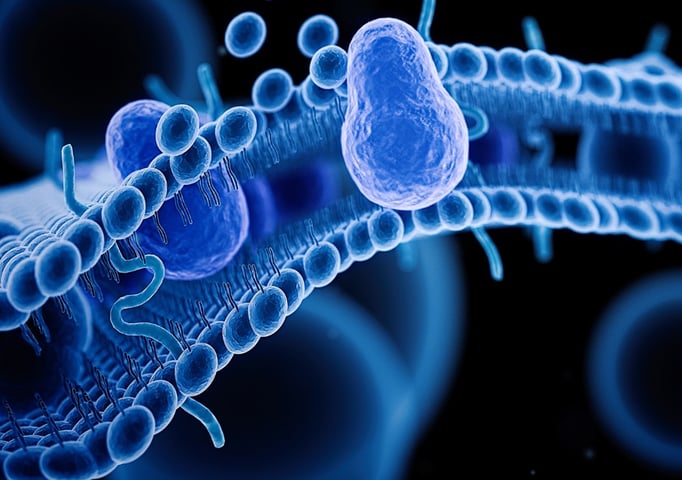
Model membrane sample systems at the solid-liquid interface enable membrane biochemistry to be studied with molecular precision using sample systems of reduced complexity to those found in vivo.
Neutron reflectometry (NR) is a technique found at large national and international facilities which allows for structure at buried interfaces to be probed. Complex biological architectures such as membranes can be structurally examined and the relative distribution of components across the surface resolved. However, NR is not a high throughput technique. Therefore, QCM-D has become a commonly utilized bench-top technique to complement structural studies on membrane models by NR and probe these over a wide range of experimental conditions [1].
As an instrument scientist I help researchers use neutron beams to examine biological membrane structures by NR. Part of my role is developing and bench testing new interfacial model membrane sample systems. Recently I have contributed to the development of two advanced model membrane systems. One, a self-assembled floating membrane system where the distance of the lipid bilayer from the bulk surface can be tuned by changing the solution salt conditions [2] and another, a planar lipid/integral membrane protein complex which can be used to examine protein folding in the membrane environment [3]. In both cases the use of QCM-D to complement NR studies and as a tool for high throughput applied usage of these advanced biomimetics has been highly beneficial.
In this talk I will give an introduction using neutron beams to examine biological structures in general and membrane structures by NR in particular. I will then discuss two recent studies which use a complementary combination of NR and QCM-D to give a precise molecular level structural and physical understanding of two new, advanced membrane biomimetic systems.
Watch the webinar to learn more about how to combine QCM-D and NR to examine membrane biochemistry at the solid-liquid Interface.
[1] LA Clifton et al, Design and use of model membranes to study biomolecular interactions using complementary surface-sensitive techniques, 2020, Advances in colloid and interface science 277, 102118
[2] LH John et al, Large scale model lipid membrane movement induced by a cation switch, 2021, Journal of colloid and interface science 596, 297-311
[3] SCL Hall et al, Surface-tethered planar membranes containing the β-barrel assembly machinery: a platform for investigating bacterial outer membrane protein folding, 2021, Biophysical Journal 120 (23), 5295-5308
Learn best practices and step-by-step methods for accurate QCM-D coating thickness measurement on QSense sensors using QSense Omni.
Compared to QCM, QCM-D measures an additional parameter, and provides more information about the system under study.
Discover how QCM-D analysis reveals real-time etching dynamics, helping optimize cleaning processes and protect surfaces from unwanted damage.
Discover how QSense QCM-D helps tackle fouling challenges across industries
Discover how QCM-D enables real-time, label-free analysis of supported lipid membrane formation, structure, and dynamics for advanced research
Learn how QSense QCM-D analysis can reveal membrane fouling dynamics and optimize cleaning strategies for more efficient water treatment
Learn how QSense QCM-D helps detect and prevent surface-induced instabilities in biologics. Join our webinar for insights and practical examples.
Learn about the top QSense sensors for analyzing biopharmaceutical drug-surface interactions in the context of IV bags.
Learn about QCM-D, Quartz Crystal Microbalance with Dissipation monitoring - an analytical tool for surface interaction studies at the nanoscale.
Dr. Luke A. Clifton, Ph.D. in Biophysical Chemistry, works as an instrument scientist in the neutron reflectometry group at the ISIS pulsed neutron and muon source at Rutherford Appleton Laboratory in the UK. Dr Clifton has developed novel bio-membrane sample systems which have been used to answer applied questions of membrane biology. His work with the neutron scattering community includes impactful studies on antimicrobial resistance, cancer, food security, and bio-membrane homeostasis, with many of these studies utilizing the sample systems he has developed.
